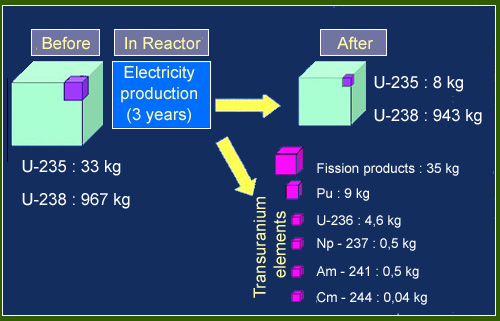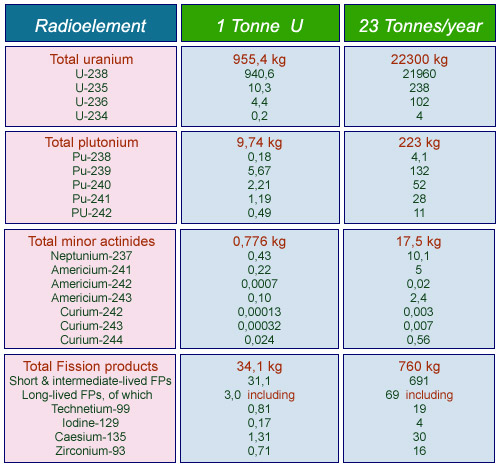Key figures on spent fuel composition
The composition of irradiated fuel removed from a reactor core depends on the initial quantity of fissile material and the energy removed from it. We will examine the example of a conventional PWR reactor generating 1 Gigawatt of electric power – as is typical of the French nuclear electric fleet – loaded with uranium enriched to 3.5%. One tonne of new fuel contains 965 kg of uranium-238 and 35 kg of fissile isotope 235.

Spent fuel composition
Distribution (in kg per ton of fuel) and mass produced by the principal radioactive elements present in fuel unloaded from an pressurised water reactor core.
© IPHC/IN2P3 (Source: Isabelle Billard)
When the fuel is unloaded, the uranium-238 inventory is largely unchanged: the fuel still contains 941 kg of this isotope. Of the original 35 kg of uranium-235 used to generate the electric power produced by the fuel, only 10 kg remains. The spent fuel therefore contains around 1% of fissile isotope 235, which is more than in naturally-occurring uranium (0.7%); as such, it can be worthwhile enriching this spent uranium in order to recycle it.
Three categories of elements are created when fuel is irradiated:
– 1) Fission products : approximately 33kg per tonne of fuel. These are formed when uranium-235 and the plutonium formed during irradiation are split. Some of the fission products have already stabilised by the time the reactor is unloaded, but the remainder is highly radioactive.
– 2) Actinides (heavier nuclei than uranium) form when uranium captures one or more neutrons without splitting. The fuel contains almost 10kg of plutonium, representing around 1% of the total mass. Fissile 239 isotope is the most abundant (5.7 kg). Actinides other than plutonium (neptunium, americium and curium) are less abundant, totalling around 800 g per tonne of fuel. These isotopes are known as minor actinides. The main minor actinide is neptunium-237.
– 3) Activation products resulting from irradiation of the materials located in hot parts of the reactor, and in particular, metal structural components, support grids and the cladding around fuel pellets. The main activation products are cobalts-58 et 60, manganese_54, antimony-124, tritium and carbon-14. Activation products are radioactive, but almost all have short half-lives. In addition, the quantity may be limited by carefully selecting the elements present in such structures. For example, zirconium alloy steel grades have been developed, in which the cobalt content is minimised, thereby reducing formation of highly radioactive cobalt-60.

Detailed composition
Distribution of the main radioactive elements present in fuel unloaded from an irradiated pressurised water reactor core in standard operating conditions (burn-up of 33 GWd/t), given for one ton of fuel (left column) and for the 23 tons used annually in the reactor (right column). The majority of the 31.1 kg of short-lived and intermediate-lived fission products stabilise within around ten years, essentially leaving only approximately 0.1 kg of strontium-90 and 0.1 kg of caesium-137, two radioelements with 30-year radioactive half-lives.
© IN2P3 (Source CEA)
Most fission products have short radioactive half-lives and stabilise within a few years. Two intermediate-lived fission products, strontium-90 and caesium-137, have radioactive half-lives of around 30 years. Lastly, a small number of fission products with very long half-lives disappear very slowly, but are consequently radioactive at low levels only. Most actinides also disappear slowly.
In 2000, a total of 220,000 tonnes of irradiated fuel was unloaded from reactors world-wide, including 1,400 tonnes of plutonium and substantial quantities of actinides and fission products. Each year, the total global inventory of such materials increases by 11,000 tonnes, including 70 tonnes of plutonium.
Other articles on the subject « Spent nuclear fuel »
Reactor unloading
Fuel unloading and initial pool storage of spent fuel The fuel load in a conventional pressurised[...]
Spent fuel Burn-up
Irradiation rate and energy supplied by fuel The energy produced by a nuclear power plant is prop[...]
Waste radioactivity decrease
A natural but slow decay process As natural radioactivity progressively decays, the radioactivity[...]
Spent fuel decay heat
Significant, slow-to-decline heat release The heat released by radioactive disintegration is a ke[...]
Spent fuel radiotoxicity
A risk indicator more pessimistic than radioactive activity Radioactivity is an imperfect descrip[...]